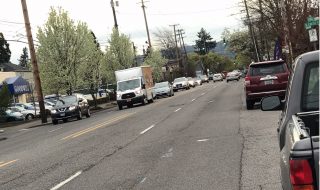
(Photo: Jonathan Maus/BikePortland)
The Oregon Transportation Commission (OTC) will make an important decision at their meeting on Tuesday (12/1). As we shared last week, the Oregon Department of Transportation is asking the OTC to approve how $2.2 billion in transportation funds should be allocated in the 2024-2027 timeframe. It’s the first step in the process to update the “STIP”, the Statewide Transportation Improvement Program.
In the weeks and months leading up to tomorrow’s meeting, ODOT staff presented the public with five funding “scenarios”. While most of the funds are already spoken four, about one-third or $600 million of the ($2.2 billion) total is at play in this allocation debate. While the lines between them often blur, the categories these funds can be placed i are “Fix-it” (maintenance), “Enhance” (new highway projects), “Safety” (focus on injury/fatality reduction), and “Non-highway” (bicycle, walking, and transit-focused projects).
Advertisement
With climate change on everyone’s mind, many groups urged the OTC to adopt the Non-Highway scenario because, according to ODOT analysis, it would have the largest positive impact on reduction of greenhouse gas emissions. Or, in the words of the Oregon Bicycle and Pedestrian Advisory Committee (OBPAC) Chair Hau Hagedorn in a letter to the OTC dated November 20th, “This is the only option that focuses major investments in the areas that will allow ODOT to make measurable progress on reducing greenhouse gas emissions and improving multimodal mobility while addressing serious social inequities centered around transportation options.”
Opting for the Non-Highway scenario would not lead to the reforms and outcomes many of us dream about at ODOT, but it would signal that the OTC was serious about pushing ODOT in a different direction.
Last week ODOT staff came out with two scenarios they’ll recommend to OTC members on Tuesday. According to ODOT’s letter to the OTC dated November 24th, the new “hybrid” scenarios are based on their read of public feedback and, “seek to balance funding across categories and outcomes across the goals to minimize negative impacts.”
Advertisement
The scenarios are named “Hybrid 1: Non-Highway/Fix-It” and “Hybrid 2: Non-Highway/Enhance”. Both would boost spending in the Non-Highway category by at least 50% over the existing “baseline” scenario and only differ in how much they allocate to Fix-It and Enhance categories. Hybrid 1: Non-Highway/Fix-It would add no new funding for Enhance projects and would increase Fix-It spending by 3% over current levels. Hybrid 2: Non-Highway/Enhance would boost Enhance (highway) funding by $200 million, including $90 million in discretionary funds.
These hybrid options differ substantially from the Non-Highway scenario pushed for by OBPAC and advocacy groups like Oregon Environmental Council, Bike Loud PDX, and others. The original Non-Highway scenario would have increased spending in the Non-Highway category by 130% over the baseline and reduced Fix-It by 17%. Because these hybrid scenarios are new, they haven’t been ranked against ODOT’s goals and outcomes.
The OTC meeting starts at 9:00 am on Tuesday (12/1). The 2024-2027 STIP decision is scheduled to begin at 12:50 pm. See the OTC website for more details.
— Jonathan Maus: (503) 706-8804, @jonathan_maus on Twitter and jonathan@bikeportland.org
— Get our headlines delivered to your inbox.
— Support this independent community media outlet with a one-time contribution or monthly subscription.


